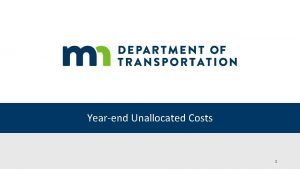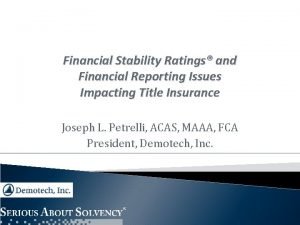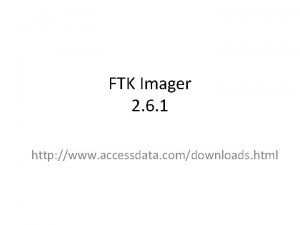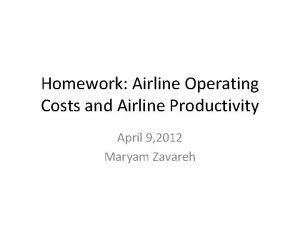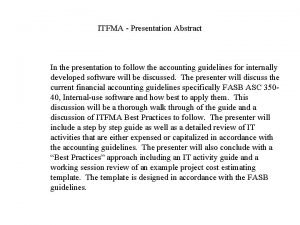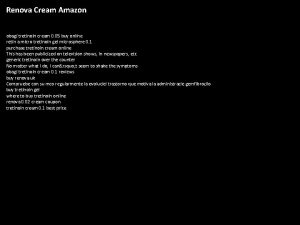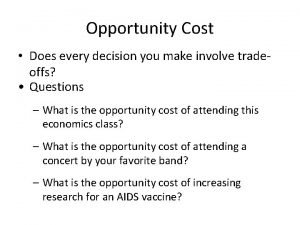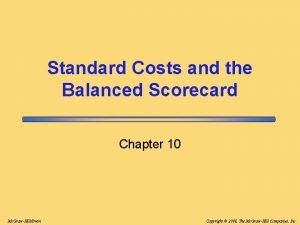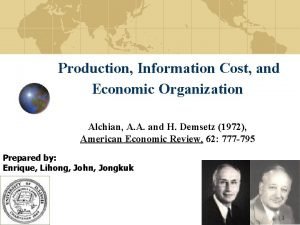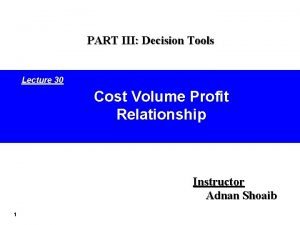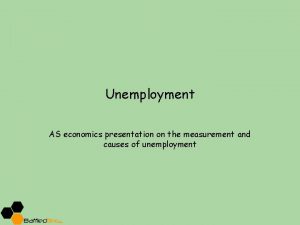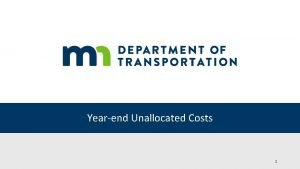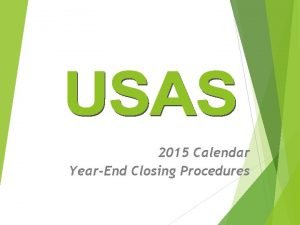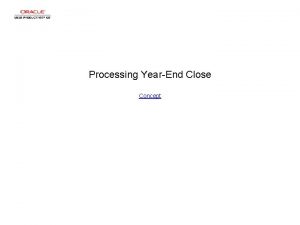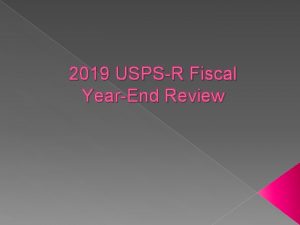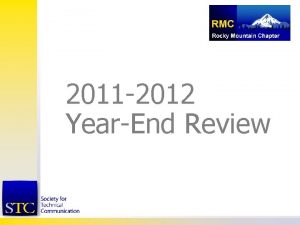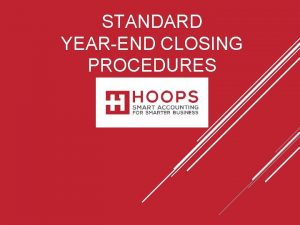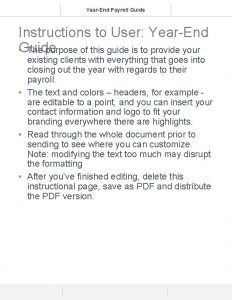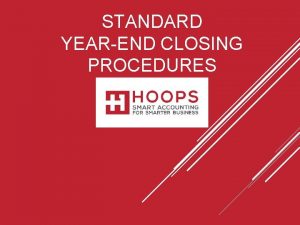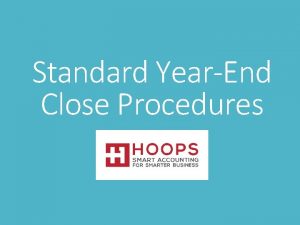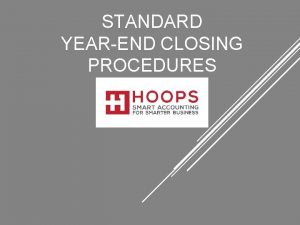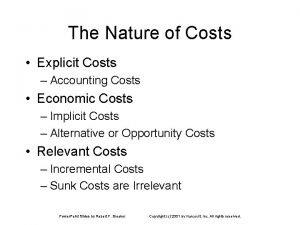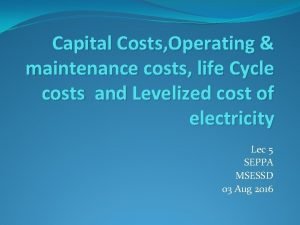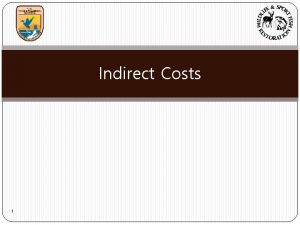Yearend Unallocated Costs 1 What are unallocated costs


















- Slides: 18

Year-end Unallocated Costs 1

What are unallocated costs? • Unallocated costs are costs that cannot be directly related to: • A specific road • Construction/engineering project • Equipment unit • Every effort should be made to charge costs directly to the appropriate cost area before using unallocated accounts. • Unallocated costs are divided between two categories: • Highway related • Administration • Maintenance • Construction/engineering • Shop/equipment • Non-highway related • These should be isolated and will not be distributed highway activities 2

Administrative costs • Are expenses that are not directly attributable to a specific activity • Any unapplied administrative costs will be included with the maintenance reporting by road system as unallocated • Examples of unallocated administrative costs are: • Administrative salaries • Engineering computer program/service contract • Fringe Benefits • County FICA, Medicare, PERA Expenses • County Health Insurance Expense for employees • Vacation, sick leave, personal leave, military leave, etc. • Minor office furniture/equipment • Office supplies • Training and education • Travel and lodging 3

Administrative costs (continued) • A portion of the engineer’s salary may be moved to the construction area • Based on a fair estimate of the engineer’s time • Documentation should be on file to show this estimate was determined • Some costing systems distribute Fringe Benefits directly to labor costs by actual Fringe Benefit Costs for • The period by actual labor activities OR • inflate actual labor rates by a Fringe Benefit Overhead Rate. 4

Administrative costs (continued) • If Fringe Benefits are applied to actual labor costs • The amount applied will appear in a separate column on various reports provided by the costing system • The credit offset for the Fringe Benefit Expense will be cash or a liability account • If Fringe Benefits are applied by inflating actual labor rates by a Fringe Benefit Overhead Rate • The labor cost column on various reports will be inflated by the Fringe Benefit Overhead Rate • Reports may be printed including or excluding the Fringe Benefit Overhead Rate • The credit offset for the Fringe Benefit Overhead Rate is included in the Fringe Benefit section of the unallocated costs 5

Administrative costs (continued) • Fringe Benefit Overhead Rate Calculation • Isolate and identify all benefits for full time employees that are a part of the county’s employment package. • Identify the total labor dollars worked for full time employees • Calculate the Fringe Benefit Overhead rate by dividing the Fringe Benefits by the total labor dollars for full time employees. 6

Administrative costs (continued) Fringe Benefit Overhead Rate Calculation 7

Construction costs • Unallocated construction costs • Expenses relating to construction operations that cannot be identified to a particular construction project. • The costs in these accounts should be prorated to engineering based on total costs of the projects at year-end. • If the county chooses, they may seek reimbursement of these engineering costs using their State Aid allocation. • Examples of unallocated construction costs include: • Alignment surveys • Cross section stock piles • Drafting supplies • Engineering expense • Engineering field work • Field engineering supplies • General permits • Road studies • Wetlands bank/mitigation 8

Construction costs (continued) • Education and training costs related to the county engineering staff • Are not allowed to be prorated to construction projects or individual roads • These costs should be included in the administrative unallocated dollar amount on the maintenance report by road system 9

Maintenance costs • Unallocated maintenance costs • Are maintenance expenses that are difficult to associate with a particular road • All efforts should be made to charge to the individual roads before using unallocated maintenance accounts • After costs have been accumulated in each unallocated account • They may be spread to the individual roads in the appropriate maintenance account • Unallocated maintenance costs may be distributed to the roads based on • Total mileage • System mileage • Surface mileage • Labor • Number of intersections, curves, and hills • The formula used to distribute unallocated costs will be determined by the type of unallocated cost 10

Maintenance costs (continued) • Examples of unallocated maintenance costs include • Annual bridge inspections and report • Bridge inspections (not related to a project) • Building barricades • Gravel (stockpiled, crushing, prospecting) • Maintenance supplies for specific maintenance accounts (brooms for minor surface maintenance sweeping) • Salt and sand, materials and mixing costs • Sign materials • Straightening sign posts • Traffic studies/counts • Weight restrictions • Weight scale calibration 11

Maintenance costs (continued) • Most unallocated costs • Will be distributed by mileage • Some costs that will be distributed based on special distribution formulas • Each county should develop a method of allocating materials they choose to spread that works best for them • Salt and sand is a good example of a special distribution formula • It’s usually applied to bituminous or concrete surfaces only at intersections, curves and hills • A survey of all road systems should be done to determine the number of intersections, curves and hills on bituminous or concrete roads • Example • CSAH regular: 120 intersections, 55 curves, 30 hills = 205 • CSAH municipal: 110 intersections, 20 curves, 3 hills = 133 • County roads: = 45 30 intersections, 5 curves, 10 hills 12

Maintenance costs (continued) • Based on this example • The percentage of salt and sand distributed to CSAH regular would be 54% • CSAH municipal would be 35% • County roads would be 11% • The salt and sand would be distributed to each road program • Based on the calculated percentages to bituminous or concrete surfaces only • Using this formula will place more costs on the CSAH municipal roads since the number of CSAH municipal miles are usually the least of the county’s road systems. 13

Shop/equipment costs • Unallocated shop and equipment costs are expenses • Relating to shop and equipment operations that cannot be identified to a particular unit • Examples of unallocated equipment costs include • Shop overhead (utilities) • Shop supplies and small tools • Miscellaneous repair parts • Building and grounds maintenance • Inventory adjustments for fuel • Inventory adjustments for parts and replacements 14

Shop/equipment costs - Continued • Inventory adjustment • Should be held to a minimum through the use of good inventory control and management • Should become part of cost added to equipment • And prorated back to the units in developing a rate • Or ultimately become an entry into adjustment to equalize depreciation 15

Non-highway related costs • Non-highway costs • Should be accumulated in the area for county dollars or authorized work for others. • Non-highway related activities must not be included in the unallocated costs which are distributed to the road system • Non-highway costs may include costs associated with: • Capital outlay • Ditch fund for flood control • Agricultural inspection • Work for others • Other non-highway related costs • 911 signing 16

Conclusion • Every effort should be made to charge costs directly to the appropriate cost area before using unallocated accounts. • Unallocated costs are divided between two categories – highway related and nonhighway related • The highway related unallocated costs are divided into categories for administration, maintenance, construction/engineering and shop/equipment • Non-highway related unallocated costs should be isolated and will not be distributed highway activities • A worksheet for distributing unallocated costs at year-End is available on the State Aid Finance Worksheets & Applications webpage 17

Questions? Mike Kilanowski michael. kilanowski@state. mn. us 651 -558 -6508 18
 Mikael ferm
Mikael ferm Unallocated cost
Unallocated cost Unallocated loss adjustment expense
Unallocated loss adjustment expense Accessdata ftk imager
Accessdata ftk imager Cost concept and classification
Cost concept and classification Airline operating costs
Airline operating costs Fixed asset write off
Fixed asset write off How to calculate inflation rate
How to calculate inflation rate Piecewise functions examples
Piecewise functions examples Itfma 2019
Itfma 2019 Obagi costs
Obagi costs The cvp income statement classifies costs
The cvp income statement classifies costs For every decision you make there is a trade-off
For every decision you make there is a trade-off Standard costs and balanced scorecard
Standard costs and balanced scorecard Production, information costs, and economic organization
Production, information costs, and economic organization Chapter 18 responsibilities and costs of credit
Chapter 18 responsibilities and costs of credit Cvp income statement format
Cvp income statement format Did the benefits of roman expansion outweigh the costs
Did the benefits of roman expansion outweigh the costs Cost of unemployment
Cost of unemployment

